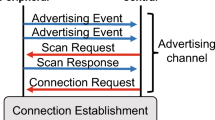Abstract
We estimate the location of a WLAN user based on radio signal strength measurements performed by the user's mobile terminal. In our approach the physical properties of the signal propagation are not taken into account directly. Instead the location estimation is regarded as a machine learning problem in which the task is to model how the signal strengths are distributed in different geographical areas based on a sample of measurements collected at several known locations. We present a probabilistic framework for solving the location estimation problem. In the empirical part of the paper we demonstrate the feasibility of this approach by reporting results of field tests in which a probabilistic location estimation method is validated in a real-world indoor environment.
Similar content being viewed by others
REFERENCES
P. J. Brown, J. D. Bovey, and X. Chen, “Context-Aware Applica-tions: From the Laboratory to the Marketplace,” IEEE Pers. Com-mun., Vol. 4, pp. 58–64, October 1997.
G. Chen and D. Kotz, “A Survey of Context-Aware Mobile Comput-ing Research,” Technical Report TR2000-381, Department of Computer Science, Dartmouth College, November 2000.
J. Hightower and G. Borriello, “Location Systems for Ubiquitous Computing,” Computer, Vol. 34, No. 8, (Special Issue on Location-three meters. aware Computing pp. 57–66, August 2001.
U. Leonhardt, “Supporting Location-Awareness in Open Distributed Systems,” Ph.D. Thesis, Department of Computing, Imperial College, London, May 1998.
P. Bahl and V. N. Padmanabhan, “Radar: An In-Building RF-Based User Location and Tracking System,” Proc. IEEE INFOCOM 2000, Vol. 2, pp. 775–784, Tel-Aviv, Israel, March 2000.
N. Bulusu, J. Heidemann, and D. Estrin, “GPS-less Low Cost Outdoor Localization for Very Small Devices,” IEEE Pers. Com-mun., Vol. 7, pp. 28–34, October 2000.
P. Myllymäki, T. Roos, H. Tirri, P. Misikangas, and J. Sievänen, “A Probabilistic Approach to WLAN User Location Estimation,” Proceedings of the 3rd IEEE Workshop on Wireless Local Areas Networks, Boston, USA, September 2001.
P. Castro, P. Chiu, T. Kremenek, and R. Muntz, “A Probabilistic Room Location Service for Wireless Networked Environments,” 3rd International Conference on Ubiquitous Computing (Ubicomp est 2001), Atlanta, September-October 2001.
T. S. Rappaport, J. H. Reed, and B. D. Woerner, “Position Location UsingWireless Communications on Highways of the Future,” Commun. Mag., Vol. 34, pp. 33–41, October 1996.
J. Syrjärinne, “Studies of Modern Techniques for Personal Position-ing,” D.Sc. Thesis, Tampere University of Technology, Tampere, 2001.
M. A. Youssef, A. Agrawala, A. U. Shankar, and S. H. Noh, “A Probabilistic Clustering-Based Indoor Location Determination System,” Technical Report CS-TR-4350 and UMIACS-TR-2002-30, University of Maryland, March 2002.
J. O. Berger, Statistical Decision Theory and Bayesian Analysis, Springer-Verlag, New York, 1985.
J. M. Bernardo and A. F. M Smith, Bayesian theory. John Wiley & Sons, New York, 1994.
D. W. Scott, Multivariate Density Estimation: Theory, Practice, and Visualization, John Wiley & Sons, New York, 1992.
P. Kontkanen, P. Myllymäki, T. Silander, H. Tirri, and P. Grünwald, “On predictive distributions and Bayesian networks,” Stat. and Comput., Vol. 10, pp. 39–54, 2000.
R. O. Duda and P. E. Hart, Pattern Classification and Scene Analysis, Wiley Interscience, New York, 1973.
J. B. Andersen, T. S. Rappaport, and S. Yoshida, “Propagation Measurements and Models for Wireless Communications Channels,” IEEE Commun. Mag., Vol. 33, pp. 42–49, January 1995.
B. H. Fleury and P. E. Leuthold, “Radiowave Propagation in Mobile Communications: An Overview of European Research,” IEEE Commun. Mag., Vol. 34, pp. 70–81, February 1996.
R. Pattuelli and V. Zingarelli, “Precision of the Estimation of Area Coverage by Planning Tools in Cellular Systems,” IEEE Personal Commun., Vol. 7, pp. 50–53, June 2000.
G. Wölfle and F. M. Landstorfer, “Prediction of the Field Strength inside Buildings with Empirical, Neural, and Ray-optical Prediction Models,” 7th COST-259 MCM-Meeting, Thessaloniki, Greece, 1999.
T. Tonteri, “A Statistical Modeling Approach to Location Estimation,” Master's thesis, Department of Computer Science, University of Helsinki, May 2001.
P. Bahl, V. N. Padmanabhan, and A. Balachandran, “Enhancements to the RADAR User Location and Tracking System,” Technical Report MSR-TR-00-12, Microsoft Research, February 2000.
K. Pahlavan, X. Li, and J.-P. Mäkelä, “Indoor Geolocation Science and Technology,” IEEE Commun. Mag., Vol. 40, No. 2, pp. 112–118, 2002.
Author information
Authors and Affiliations
Rights and permissions
About this article
Cite this article
Roos, T., Myllymäki, P., Tirri, H. et al. A Probabilistic Approach to WLAN User Location Estimation. International Journal of Wireless Information Networks 9, 155–164 (2002). https://doi.org/10.1023/A:1016003126882
Issue Date:
DOI: https://doi.org/10.1023/A:1016003126882




